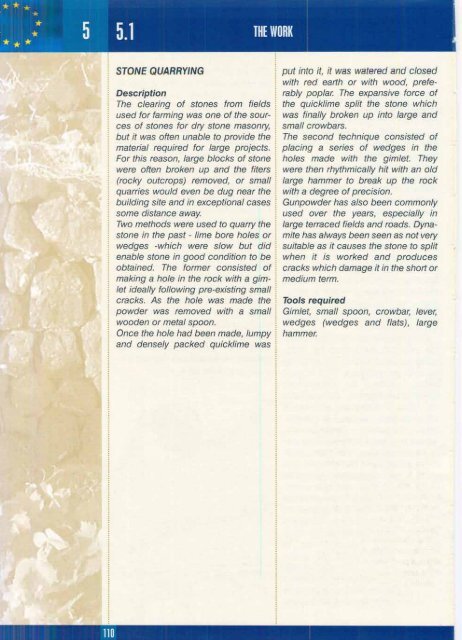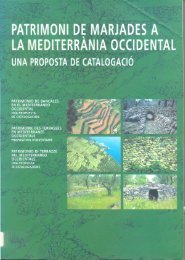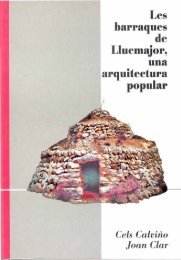La pedra en sec. Materials, eines i tècniques tradicionals a les illes ...
La pedra en sec. Materials, eines i tècniques tradicionals a les illes ...
La pedra en sec. Materials, eines i tècniques tradicionals a les illes ...
Create successful ePaper yourself
Turn your PDF publications into a flip-book with our unique Google optimized e-Paper software.
*** '<br />
*<br />
* * *: 5 5.1 THE WORK<br />
Description<br />
The clearing of stones from fields<br />
used for farming was one of the sources<br />
of stones for dry stone masonry,<br />
but it was oft<strong>en</strong> unable to provide the<br />
material required for large projects.<br />
For this reason, large blocks of stone<br />
were oft<strong>en</strong> brok<strong>en</strong> up and the fiters<br />
(rocky outcrops) removed, or small<br />
quarries would ev<strong>en</strong> be dug near the<br />
building site and in exceptional cases<br />
some distance away.<br />
Two methods were used to quarry the<br />
stone in the past - lime bore ho<strong>les</strong> or<br />
wedges -which were slow but did<br />
<strong>en</strong>able stone in good condition to be<br />
obtained. The former consisted of<br />
making a hole in the rock with a gimlet<br />
ideally following pre-existing small<br />
cracks. As the hole was made the<br />
powder was removed with a small<br />
wood<strong>en</strong> or metal spoon.<br />
Once the hole had be<strong>en</strong> made, lumpy<br />
and d<strong>en</strong>sely packed quicklime was<br />
put into it, it was watered and closed<br />
with red earth or with wood, preferably<br />
poplar. The expansive force of<br />
the quicklime split the stone which<br />
was finally brok<strong>en</strong> up into large and<br />
small crowbars.<br />
The <strong>sec</strong>ond technique consisted of<br />
placing a series of wedges in the<br />
ho<strong>les</strong> made with the gimlet. They<br />
were th<strong>en</strong> rhythmically hit with an old<br />
large hammer to break up the rock<br />
with a degree of precision.<br />
Gunpowder has also be<strong>en</strong> commonly<br />
used over the years, especially in<br />
large terraced fields and roads. Dynamite<br />
has always be<strong>en</strong> se<strong>en</strong> as not very<br />
suitable as it causes the stone to split<br />
wh<strong>en</strong> it is worked and produces<br />
cracks which damage it in the short or<br />
medium term.<br />
Tools required<br />
Gimlet, small spoon, crowbar, lever,<br />
wedges (wedges and flats), large<br />
hammer.




